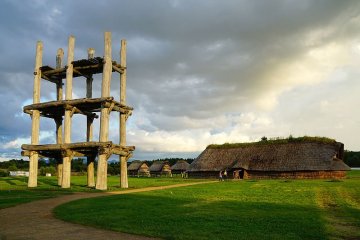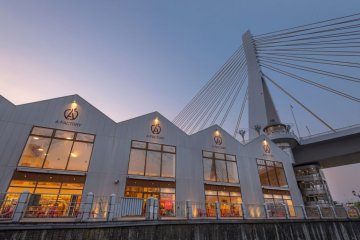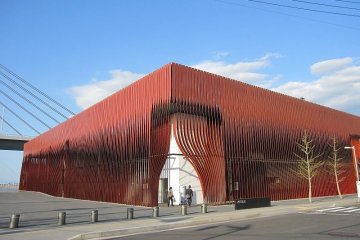

Since opening in July 2006, the Aomori Museum of Art has been active in having exhibitions, concerts, plays, and workshops by Aomori-native artists and performers. Most notably, Yoshitomo Nara, Shiko Munakata, Shuji Terayama, and Toru Narita are forerunners of the museum’s exhibits; with The Aomori Dog by Yoshitomo Nara being the museum’s symbol.
Closed the 2nd and 4th Mondays monthly.
The museum architecture itself is also an important part of the surrounding landscape and features as an exhibit itself. Designed by Jun Aoki to resembled the nearby Sannai Maruyama Historical Site excavation area, the simple walls and shape lend itself well to the beauty of the land. Atsuki Kikuchi, responsible for the visual identity of the building, decorated the exterior with stylized trees that represent the Aomori landscape and its connection to nature.
With four floors of art to explore, the Aomori Museum of Art contains a theater, community gallery, restaurant, shop, and more in addition to its galleries. The galleries also contain artwork from international artists, such as Kandinsky, Klee, Matisse, Rembrandt, and Picasso. Visit this museum that brings nature and art together in a harmonious union.
10 minutes by car from JR Shin-Aomori station or 20 minutes from JR Aomori station.

The Sannai-Maruyama Site is a historically important archeological site and museum located in Aomori Prefecture. The ruins belonged to a large Jomon-period settlement and were originally rediscovered in 1992. The people of the Jomon age were known for their sedentary lifestyles and this settlement has provided artifacts as well as a look into the lives of the people of the past. Excavation of the site unearthed storage pits and above-ground storage further cementing the people as belonging to the region. The site has been designated a Special National Historical Site of Japan. Visitors may make their way to the site and see the reconstructions of Jomon-style architecture and artifacts native to the site. The Sanmaru Museum exhibits over 1700 artifacts and about 500 Important Cultural Properties that were all excavated from the Sannai-Maruyama site. Inside the museum, guests will be able to watch a video on the lifestyle of the Jomon people (with English audio devices available upon request). Alongside the artifacts from the Sannai-Maruyama site are figures that best represent how scientists believe the tools were used.

A-Factory in Aomori Prefecture is a premier duty-free marketplace that houses and sells various products, such as sweets, processed goods, fresh vegetables and fruits, and more wonders from all over Aomori, most notable are, of course, Aomori apples. Aomori remains the largest and most popular producer of apples in Japan. Opened in late 2010, in conjunction with the extension of the Tohoku Shinkansen line to Aomori, the market is located on the Aomori Bay and makes for a striking outline against the Aomori bay Bridge. For tourists visiting the capital of the prefecture, A-Factory is an easy and convenient stop for specialty products. As well as being a market for prefectural goods, the factory also serves as the brewery for an in-house apple cider that visitors can see being produced. By purchasing a tasting card, guests can even sample the freshly produced cider of A-Factory. In addition, there are several eateries and restaurants inside, ranging from burgers to apple fries. All of the shopping and sampling and eating that awaits inside of A-Factory can also be enjoyed on the terrace or with a bay view from the large windows.

"睡魔之家WA・RASSE于2011开幕,是青森车站周边复兴计划之一。在这里有深入的睡魔祭历史、介绍、以及花车——每年均有四台新的花车轮流展示。 以青森地区的祭典爱好者为对象,WA. RASSW以每年在青森湾埠头举办的睡魔祭为主。博物馆的外观设计也是源自于青森的根本,对许多游客来说看起来像是红色蝴蝶结,其实是重现透过青森古老森林的光线。这个有趣的外观设计,也帮助博物馆减少外来的自然光。 游客从睡魔之家WA・RASSE的2楼开始导览。在学习祭典的相关知识,并阅览过历史照片后,游客们会被带到一个阳台,俯瞰整个主要展示区域。暗沉灯光的那里,便是真的睡魔花车展示的地方。由于房间偏暗,能看到花车以如同夜间祭典般的鲜艳色彩展示。 这里也有其他互动活动,以及一个30分钟长的体验,一天有三次。看着这些展示,游客们可以体会青森睡魔祭的实际参加感受。